The Making Of The Hobbit: The Desolation Of Smaug
The cast and crew talk returning to Middle-earth…

The second part of a trilogy
Peter Jackson: We’re trying to make The Desolation Of Smaug work on multiple levels. ‘Cause each movie you want each movie to be a piece of entertainment in itself, obviously.
But we also want the three movies of The Hobbit to have a story arc that obviously carries over the three movies, and then beyond that we want the Hobbit movies to sit with the Lord Of The Rings movies, and have story arc that continues on.
So we end up with six movies that starts with The Unexpected Journey and finished with The Return Of The King , and that has a unity to it. We’re trying to juggle all those different aims as best we can.
Richard Armitage: Peter really did shoot most of the story as one piece. Occasionally we had to chop around in term of worlds, because each world contains its own set of obstacles.
So Beorn’s world, the woodland realm for example – nobody really knew that it was going to be three movies, although there was a sense towards the end. He was shooting a lot of material.
It was only when we came to do pick-ups this year that we were taking moments from all over the place and making sense of the story, but by then, of course, we’d seen the first film, and I feel like I’d matured into the character. It was like adding another layer of finish, which was nice.
Philippa Boyens: It has a different feel at the end of this story. It becomes something else, other than a children’s tale.
That was one of the reason we felt that we needed to… Once we got to that place, the Battle of the Five Armies, you really did feel like you’d stepped into another world. You’d stepped into the Lord Of The Rings .
And then bringing in things like Dol Guldur, and the discovery of who and what that Necromancer is and what that means. Again, you’re in a different tale to the little tale of The Hobbit.
At that point you have to say, ‘Do we tell this piece of the story?’ We know from the Lord Of The Rings where Gandalf goes when he leaves them. We know what he does. Do you show that or not? And once we decided yeah, we wanted to do it, it became three films.
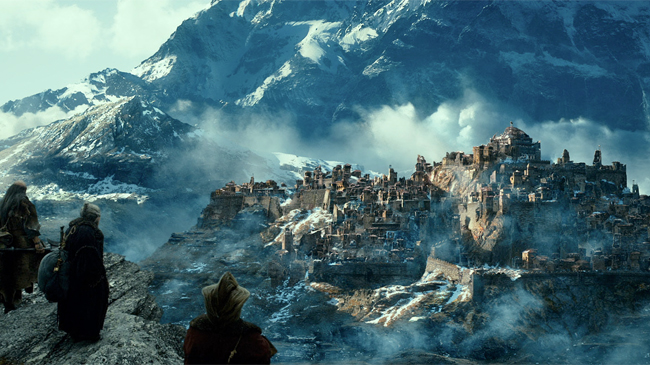
Tackling the middle movie
Peter: People go to the movie knowing that it’s not going to get to the end. Just on Lord Of The Rings , it took three movies for Frodo to get to Mount Doom, so you know, that’s what people understand.
And that’s the fun of a trilogy, too, that you don’t have to abide by the rules that a normal, single movie has to.
Richard: I feel like Peter’s making the movie look completely different. And it’s deliberate. He’s pushing the boundaries of cinema by its look and feel.
You have 50 per cent of the material built so you have sense of what it’s going to be like, but in regards to the second film, like the end sequence with the dragon, I have no concept of what that was going to be like.
So it’s a great surprise when you see it and you just hope that whatever your input has been, it’s been valuable to work with.

Getting into character
Martin Freeman: My route into it was… I mean the physicality of it for me… I sort of saw Bilbo as a meerkat. You know, I saw him as a creature that’s not very high up the food chain. Something that could be hunted, and something that needed to constantly be on guard.
So his peripheral vision was very good. ‘Cause he was definitely a flight creature rather than a fight creature. I mean in this second one… But intrinsically, who he is, is a flight creature.
Yeah, just playing around with it really. I think it’s hard till you come on to set and start work. Because whatever decisions you come up with in your bathroom might not apply at all when it comes to the doing of it.
So I always try to leave room for God to walk through the space. You know, for the unknown to happen.
Richard: I don’t recognise myself, which is great. There were many aspects of my own character that I could bring to him. Many bits of my dad, maybe. Certainly stubbornness was something I accessed very easily, because I’m ridiculously stubborn.
I also wanted him to have a physical prowess, which is talked about by Tolkien. And I had certain skills that I could achieve. We had to fake a little bit. But it’s a mixture. He’s similar to me and then in many ways he’s the antithesis to me.
Luke Evans: There was a lot of archery training. It’s a long bow, so it’s like two metres 10 in height. It was taller than me. And I had to learn it…
Usually you shoot a bow and arrow with your palm facing you, but because the bow is so big the extension had to be quite large, so I learnt how to shoot it with my palm facing outwards, so I could extend past my face.
So there was lot of little tricks to know. And then pulling those giant arrows out of the quivers. Yeah, there was lots to learn.
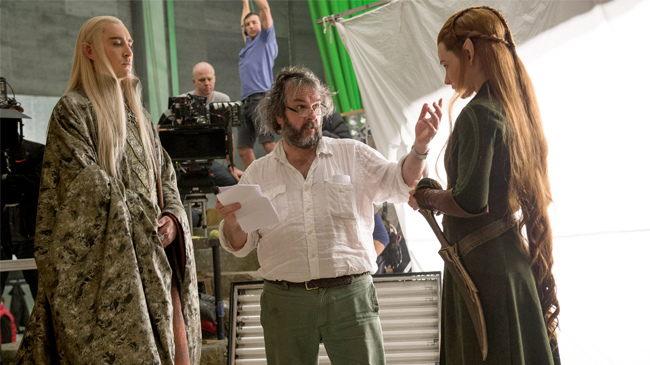
That family feeling
Richard: The world ‘family’ gets thrown around with Peter, but there’s a good reason for that. He does invite you to his dinner table. Literally you go and eat dinner with him. And you have your script meeting with him in his living room and their kitchen, and so you’re made to feel like you’re part of their family.
Also, half of the dwarfs came from the Northern Hemisphere and half of them came from the Southern Hemisphere. We were away from home and so they were, sort of… they weren’t obliged to make us feel at home, but they certainly took that onboard.
Socialising was really part of making the film work. ‘Cause those relationships, from the actors, really helped us as characters to get that feeling that this quest was unified, you know?
Martin: I would not kill for Peter Jackson, but I would punch. Very hard. In the torso.
Luke: There’s nothing quite like the Hobbit , or The Lord Of The Rings , and I think it is the size it is because Peter wants it to be like that.
It’s Peter’s journey as much as it is the films. He wants something to remember, and he wants to break boundaries, and that’s why we’re using this amazing new technology, this camera trickery, and all of these different things that they’ve design down there.
And I think it really works. It really works.
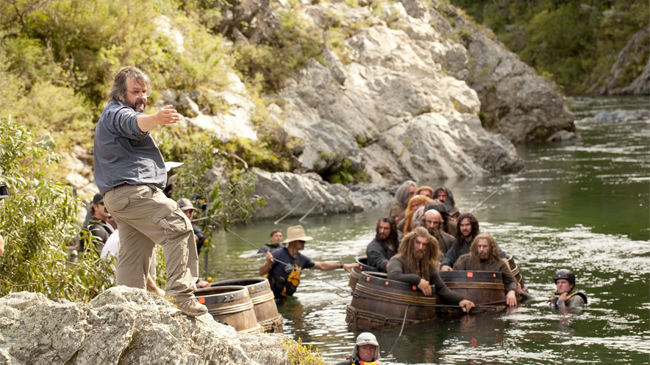
Interacting with the fans
Peter: Well, we’ve done that for a long time. I mean we did a degree of it on The Lord Of The Rings . And TLOTR was where we realised that it was much more enjoyable to interact with the fans.
At the very beginning of TLOTR we literally didn’t want anybody knowing anything, and we had a real policy of not allowing anybody around.
Look, I just think it’s one of those things I enjoy doing. There’s no real strategy behind it. We do have all the blog that we do.
We show a lot of behind the scenes, but we’re always very careful about what we show. I always look at them very, very carefully, and there’s things that I take out to save the surprises. So we show a lot of what happens without actually giving away too much of the movie. That’s the balance of it.
Philippa: We’ve been really lucky actually. What I’ve found, meeting people who [ like Tolkien ], they think I’m, like, a Tolkien scholar. I’m so not!
I mean I’ve met Tolkien scholars and they’re the real deal. I’m just someone who happens to love the books. But when I do meet those people, what generally happens is you engage in a conversation of… I mean some people absolutely hate what we’ve done to it, and I understand that.
I completely respect that. Everyone should be able to have their own point of view. What I generally find is that they’re interested why we made the choice that we made. And they may have made different ones.

Key themes
Richard: The thing I was really interested in studying, which Tolkien was interested in, was the uncle-nephew relationship.
It’s quite a particular relationship, which comes up a lot in Shakespeare as well. It’s not as close as father/son. It’s actually slightly removed. It’s disenfranchising for the older party, for the paternal figure.
I felt it was another aspect of Thorin’s character, which I could really use – the care that he had for Fili and Kili. He didn’t have the authority to instruct them as a father. He could only instruct them as an officer or a king, and that created conflict.
And you see that certainly in the second film when the dwarfs divide. You feel this weight of guilt on Thorin for leaving one of them behind and forcing the other one to come with him, and it sort of falls apart a little bit.
Philippa: What you get to do [ in this film ] is embody a giant manifestation of greed. Smaug. But also the obscenity of wealth.
There is something obscene about that much gold. And we liked the idea of the giant gold statue. That’s what Thror was working on before he died – this giant golden statue.

Smaug
Peter: Well it’s interesting because, you know, the character of Smaug is the thing that I think is the most memorable thing. It’s what we focused on. Because you can tie yourself in knots thinking, ‘Well, how can we make our dragon different from everybody else dragons?’
It was one of the most frustrating things. Dragons – they’ve been in movies for the last 10 years. And when it comes to talking dragons, I couldn’t get Sean Connery out of my head. You know, that Dragonheart movie.
And ‘Smaug’ – it sounds like it’s Sean Connery saying it. ‘Smaug’. So I just thought okay, I didn’t want to create a creature that didn’t look like a dragon. I wanted him to look like a classical dragon, so in some respects that design process was fairly straightforward.
What we put a lot of our attention into was the character of Smaug. His personality. I think when people leave the movie they’re not going to be…what lingers in your mind is not how many teeth he’s got, or how big he is or what his tail looks like. It’s ultimately his personality. His voice.
Benedict: When I got the part I was thrilled. I rang Dad and I said, ‘You’ll never guess what,’ and he was really proud.
I talked to Peter very early on and said, ‘Look I’m thrilled about this but I don’t just want to be the voice of Smaug and Necromancer. I’d love to do some motion capture work.’
And he said, ‘Really?’ And I said, ‘Yeah, ‘cause I need to… it’s got to come from somewhere. I don’t want there disparity between what you see and what you hear. I want to be part of the creative process.’
There’s sort of much more insidious, nasty, psychologically conniving charisma to Smaug at the beginning, I think. Then obviously he blows up. He just becomes this raging machine.

Playing the dragon
Benedict: What the boys and girls at Weta have done – and in the sound production department as well – is masterful and they’ve taken anything I’ve offered to an imaginative level that I couldn’t even have dreamt of.
We just talked about scale a lot, and then I just started to throw myself around a mo-cap stage after the fact of my dad reading it to me, prepping for the audition, and then going to the reptile house at London zoo to have a look at that side of his nature.
Obviously this extraordinary book, this wonderful scene and this great bit of drama between the protagonist and an antagonist who speaks English, as well as flying and spouting napalm.
It was really good fun. In a weird way – obviously because I’m a biped mammal I’m limited to how much I can be a reptile – it meant that I could be childish with it and use my imagination, as I had done when my dad first read me the book.
So it was a weird, regressive but really fun way to work, and I think the others had it tougher with green screen.
In motion capture you have an environment which is as bland as a hotel room, and yet from that you create mountains, you create fire, you creates scales and wings, you create mountains of gold.
Martin: I think it’s fantastic. It looks and sounds great. I really like those scenes. They should be like the Gollum scene in the book, those scenes in the book are fantastic and iconic.
Yeah, I think they’re brilliantly done. I mean you know what you were doing on the day, but there’s nothing there. So when they’re able to render a year after the event is phenomenal, and it never ceases to amaze me.
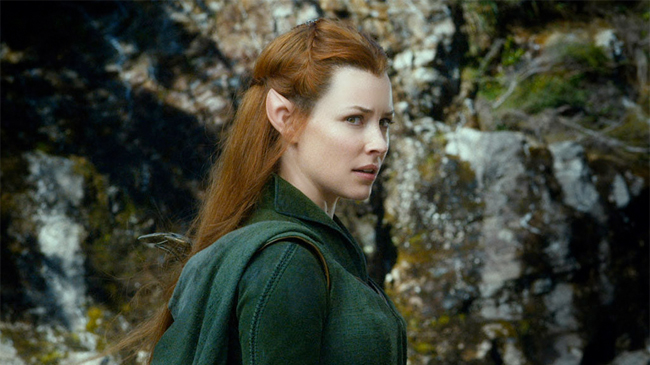
Differences from the book
Luke: The book was the first reference for me. The book. The next reference was the writers, and Peter. And Philippa and Fran. They had lots of information and they wanted to talk more about how we were going to…
I mean listen, Bard’s story is exactly the same. It’s just during those landmark moments of his story, we’ve paused a little longer to allow his history to be told a bit more. ‘Cause this guy, he does something so extraordinary. And when you read the book, you don’t really care so much about Bard really.
I mean he does what he does, but he does something amazing and it changes the course of Middle-earth’s history. So it’s just, sort of, just giving Bard his dues, basically.
Evangeline Lilly: Tolkien wrote this book in the 1930s. Women were irrelevant to men at that point, and as a result he felt the liberty to make women irrelevant in his story. And I defend him with that argument.
It’s not a criticism. He was a product of his time. That’s just the way it was back then. He then evolved as a man as the culture evolved.
You can watch that in Lord Of The Rings – in that trilogy that he was writing in the 1950s – he suddenly had more female characters featured. And then in his appendices, The Simirillion , there’s even more female characters.
They get better and better and better as he writes. He starts making them stronger and more pivotal, and giving them more interesting story lines. So I feel like Peter is trying to be as true as possible to Tolkien in Tolkien’s works as a whole. In expanding his world to incorporate all of his later ideas.
When Peter asked if I wanted to be part of a film, to be an elf, immediately I was excited and I said of course I do, this is a dream come true.
And then when they said ‘well she’s not actually in the book though’… I took pause. I stopped and said ‘Whoooa, hang on. We have to talk about this.’ And they had to convince me. I needed some convincing.
I am a Tolkien fan and these books were my favourite books growing up, so I didn’t want anyone messing with my favourite books, as the rest of the fans feel. Once they convinced me, that was it.

Favourite parts
Martin: The barrels was really good fun to do. To be in water for that – I can’t even remember for how many days it was – but to be holding onto a barrel trying to avoid rocks and drowning. So that was challenging.
It was the only sort of period of the film where I said a quick prayer before every day. Got into that wetsuit and just crossed myself and went ‘hello. If you’re there, help me concentrate.’ It’s the sort of thing that if you take your eye of the ball you could get hurt. And people did get hurt. Obviously they make it as safe as possible.
But there’s also something exhilarating about it, and once you’ve done a full day of arsing about in the water in barrel and pretending to fight off orcs, yeah, it’s really good fun.
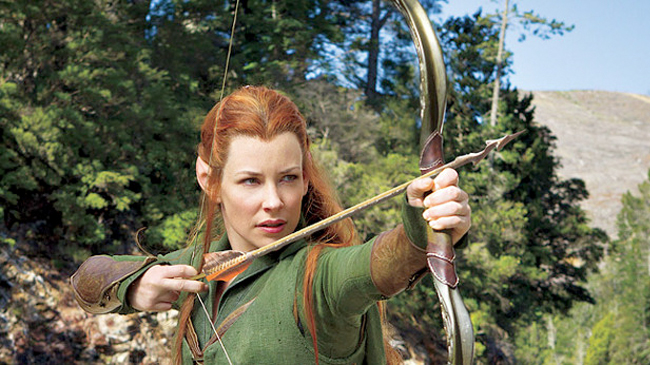
Getting tired of Hobbits?
Peter: Certainly after Lord Of The Rings I didn’t want to do The Hobbit . Not that I really could at that point because the rights weren’t available.
So I’m glad that I had a break, and I’m glad that it took a while. It needed to take a while to actually understand how to actually approach The Hobbit.
And when we decided not to approach The Hobbit as the children’s bedtime story that the book is, but to basically tell – to the use appendices in the way that Tolkien used The Hobbit in the appendices.
He was retrofitting The Hobbit into The Lord Of The Rings mythology some 20 years afterwards, and we took that approach. We were retrofitting it just as he did into the Lord Of The Rings that we’d shot.
Philippa: Yes, definitely. Writing. Very much so. I didn’t imagine that we were going to do The Hobbit . But then once we… That was a great thing about working with Gema [ Guillermo del Toro ].
Falling back in love with that world. He helped us do that, I think. Seeing it through his eyes. It kept it fresh.
But yes, absolutely. I felt that a lot. It’s hard. You repeat yourself, basically. So we try not to repeat ourselves too much.

Make-up
Martin: The feet can be very itchy. Because of the heat that rubber creates on your leg.
You just wanna get in there and scratch yourself until it bleeds. But it’s a beautifully made wig, and if a beautifully made wig is well put on, that’s fine.
Evangeline: I loved the wig. When I first arrived, the wig was a little bit more auburn. It was a little bit more brown. And I said I want it to be red. I want it fiery red. They dyed it again for me.
Luke: It’s interesting. I think there are pros and cons to that. It’s like Richard was saying the other day, ‘It’s nice to completely lose yourself inside the hair and make-up and the prosthetics and the suits, and everything.’
There was nothing of Richard left. He was able to completely disappear, whereas I have nothing to hide behind.
So I sort of see that as a really interesting thing, but believe me those three hours every morning, and then an hour in the evening, on top of the twelve-fourteen hours you were doing on set – there’s only about nine-six hours left of the day before you start the next 24 hours!
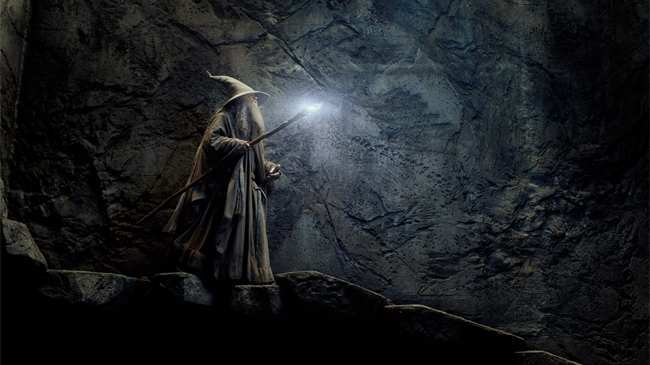
Big kids
Philippa: I actually think the star of this film is the directing, and I think Pete… he always surprises me. He just loves what he does, with a real passion.
And that’s because he wants to see it. He wants to experience it. And I think that’s what a really great director does. I think he’s pushing the envelope, in a good way, so that film keeps growing. So that what film stays alive.
Honestly, he’s a big kid. He fell in love with film making when he was really young, and that was a passion that he still has and he still wants that. And you need to be like that, because this is a very unforgiving business, not just in terms of critically.
Peter: Well, the thing that satisfies you is when somebody has seen your movie and has enjoyed it. That’s ultimately the greatest satisfaction that you get, because you’re entertaining people.
You’re in the entertainment business. It’s not something indulgent. You have a responsibility. But also I’m making movies because I was a kid who loved watching movies.
I am a kid who grew up loving fantasy movies, loving special effect, so the reason why I make movies is because I just had such a great time, the escapism, the experience of going into the cinema.
So when something I’ve made, when somebody reacts in the same way as I used to react to movies when I saw them when I was young, that’s really satisfying.
Philippa: Pete’s an extremely funny person. It’s not a bad day, going to work with him.
Evangeline: Peter works in a very chaotic manner so I was often feeling like, ‘What the heck is going on? I don’t understand up from down at this point. I don’t know where my character is, what she’s doing, what I’m supposed to say.’
And the schedule would change everyday, the script would change everyday, and it was very difficult to keep up with.
Every once in a while I would turn to Orlando [ Bloom ] and say, ‘Was it like this on Rings? This is insanity.’ And he would say, ‘Yeah, don’t worry. Peter knows what he’s doing.’

Watching with an audience for the first time
Evangeline: I was so glad to finally watch it with an audience that was actually excited about the film.
The first year I watched the premiere in New Zealand, and the theatre was full of people who essentially had already seen the movie – executives and people who had already watched the film a hundred times over.
In dailies, and then in first cut and then second cut, and they were over it already. And so to watch it in Los Angeles with a live audience who were actually fans and who had never seen it before – to have people cheering and clapping– it was wonderful.
Luke: Oh, it was wonderful. It was interesting because obviously the old characters are coming back in this movie.
You know, Legolas is back and he comes on set everybody cheers, you know. And then, like, the new characters start to come and you can see everybody just leaning a little forward going ‘Who is this new character?”
They were intrigued, seeing how they were going to connect with the rest of the story line. It was lovely.
There’s lots of nuance in this film, and detail which might have been lost if we’d had to condense it into two, and now we don’t have to do that and it’s really nice.

Extended cut
Peter: Hopefully there’s going to be a bit more in the extended version, yeah. You only decide [what] when you’re in post-production that you’re cutting it.
You’ve got no way of knowing how you’re ultimately going to shape the movie until you have it all there in front of you, and you just cut the version with everything in it. You work your way backwards from that.
Philippa: There’s some extraordinary stuff that hopefully will be in the extended cut, that we didn’t get to do. Things as simple as Bilbo taking one small cup, and how even that drove Smaug completely insane. ‘I will not part with a single coin. Not one piece of it!’
And for what? It means nothing. He can’t eat it, you know. So that’s the dragon’s sickness, and yes I think that’s not to far from what you see today. Absolutely.
There’s more. I think it’s really good. Thráin, Thorin’s father – we get to meet him, hopefully, in the extended cut.
Richard: The disappearance of Thráin was interesting because it’s the reason Thorin takes on the quest – because his father hasn’t returned for a hundred years. It’s a sort of now or never situation.
It’s something that I think was prior to the story, which they moved into present time. They realise where Thrain went and what happened to him.
It may be in the extended cut when it. It might not be. For Tolkien enthusiasts it’ll certainly be interesting.

Film three, There And Back Again
Peter: I’ll be working all the way through to next year. You know, we’ve shot the film. We’ve got a rough cut of the third one, so I’ll just be finishing that and getting the visual effects done, the music done… Still got a-ways to go.
I’m not going to give away anything too particular. I mean it’s the most emotional of the three movies. It’s the one where all the story threads… because there’s a lot of things that we have in this movie – the second movie – that are setting things up for the third movie.
Which again is the advantage of doing a trilogy. You get the ability to do that.
I mean I’m proud of the emotional impact that the third movie is going to have. I think people won’t be expecting it.
Philippa: The fighting in this film is pretty cool, I think. The fighting in the next one is just extraordinary. Because it’s real. It’s do or die.
I think Richard Armitage, as an actor, had extraordinary trajectory for his character. What’s nice about it is that I think you care about him. He had this stature as a character. And he disintegrates before your eyes, and it’s heartbreaking.
It’s wonderful. You become incredibly invested in him coming back. And that’s the thing. Does he?
Evangeline: I can tell you that Tauriel… by the end of the film, she doesn’t really know what she feels. And she does figure it out. She figures it out in the third film. But you have to wait and see what that is.
Sam Ashurst is a London-based film maker, journalist, and podcast host. He's the director of Frankenstein's Creature, A Little More Flesh + A Little More Flesh 2, and co-hosts the Arrow Podcast. His words have appeared on HuffPost, MSN, The Independent, Yahoo, Cosmopolitan, and many more, as well as of course for us here at GamesRadar+.


